Volvelles
Originating as a slide chart with overlapping rotatable paper or parchment circles that are connected in the center and contained within a manuscript or codex, the volvelle was used between the 13th and 16th centuries to predict or record external events based on the alignment of written or drawn symbols or words. Being useful just as they are intricate and striking, they are deployed often to teach concepts to individual learners. The volvelle defies the formal convention of the book due to its impermanence, and its reliance on interaction. It connects external events to the book, integrating the instrument and book, extending its relevant authority contained within the text in a practical way to obtain real world information.
Introduction
Analyzing the evolution of the volvelle from their medieval origins through the subsequent centuries through several important examples will provide an understanding of their changing functions and their eventual demise in the 16th century. Whether it was used as propaganda to promote the spread of Christianity, a tool to understand astronomical principals, or a practical guide for understanding the natural world, the medieval volvelle was based on the geocentric theories of Ptolemy. As the astronomical concepts of Copernicus became more widely adopted over this system, the volvelle soon became obsolete. It was only with the invention of the die-cut printing press that a different form of the volvelle, independent of the book, reemerged in the mid-20th century. Medieval or modern, this instrument augmented or replaced the formal narrative-driven structure of the conventional book through its ability to condense or miniaturize information into a tool that required the interaction of the reader.
In this context, the volvelle is a side-step in the evolution of the book because of its ability of to condense textual information and to radically restructure how a reader receives it. The volvelle could be considered a parallel to the reinvention of internet article and text formats as devised by Ted Nelson in Project Xanadu [1]. The volvelle is analogous to Nelson’s ideas because it changes the format of the book in the way it is read, embedding the text of the book within its structure; the same way that hypertext allows for the immediate comparison of sets of information or documents to other sources [1]. In both cases, the viewer becomes an interactive generator who “finds” their own information. The volvelle and the structure of Project Xanadu are instruments of personal discovery, which differs from the linear structure of text. It is less instructive and more constructive since it results in different information each time depending on what the reader is
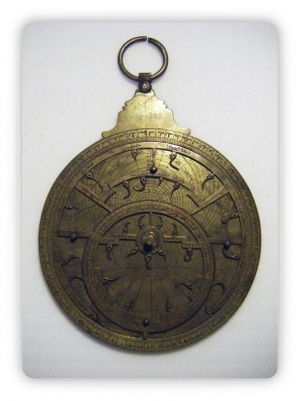
trying to discern. A volvelle augments the text of a manuscript by providing a pragmatic use or application for overarching subjects or ideas, whether it be in the fields of religion or science [2].
Origins with a Religious Overtone
The creation and use of the volvelle can be traced to medieval Europe during the 13th century, and its inclusion in manuscripts increased and grew in popularity between the 14th and 16th centuries. As an era of both deconstruction and devastation, as well as innovation and construction, the exploration of science spurred its invention. Its structure was derived directly from the astrolabe, a metal instrument that was used exclusively for astronomy, predicting the positions of the sun, moon, stars, and planets [3]. During this period, astronomy and religion had deep-rooted connections within the medieval mind, associating “the above” as a significant mystery within Christianity as well as early scientific thought [4]. The elements outside of Earth’s sphere were considered “heavenly bodies” and the volvelle helped to inform the viewer of their movements in the distant and intriguing features of the sky. The calculations done in such arenas were considered very sacred with “supernatural potential” because it entered the realm of the underlying structure of the universe, connoting for many the entrance into the mind of the Creator [3]. The volvelle was in a way a “violating” instrument that went against the normal conventions of obtaining information. With any innovation, there were initially skeptics who believed the users of volvelles were users of black magic [5]. Quick calculations or results, especially concerning the future movements of the celestial realm (which intruded on the mysterious will of God), were seen as suspect, suggesting the employment of higher forces to provide these exact answers. Machinery or instruments of this kind were thought to be a form of intrusion or cheating into the powerful realm of calculations for the purposes of prediction or divination [4].
Its practicality grew and individuals like Ramon Llull, a Franciscan monk and scholar from Spain, made use of the
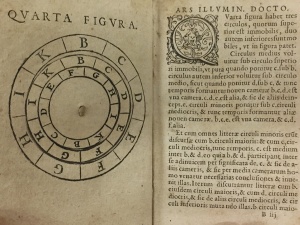
volvelle in diverse ways. The volvelles contained in his manuscript Ars Magna (1302) were designed for both scientific and religious purposes, and were used primarily as means to convert Muslims to Christianity [6]. Employing volvelles, which would answer any question about nearly all of creation through circular layers of nine letters to configure the nine names of God, provided irrefutable proof of truths akin to the scientific method as part of Christian doctrine [6]. It settled religious debates by combining attributes from both of the monotheistic religions of Islam and Christianity through triple layers of paper wheels. It was used for standardization, existing as a sort of tool of spectacular trickery. Overall, the volvelles in Ars Magna reflect how with certain methodologies can be used to make concepts more easily understandable, but were simultaneously impressive to the reader/user. Its effectiveness reflected a responsive nature in this period towards visual stimulus compared to reading text. Ars Magna astounded those unfamiliar with it, exerting Llull’s authority as a holder of profound information [6].
Evolved Uses in Science
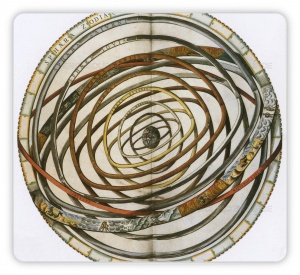
During this era of increasing scientific inquiry, the volvelle was quickly adopted as a valuable tool by religious and scientific scholars throughout Europe. The myths of black magic were debunked in favor of using the volvelle to explain the natural world. By the 14th century, the inclusion of the volvelle in manuscripts spread through the Middle East and into Western Europe, and became an instrument more widely used for strictly scientific purposes. The physical structure of the volvelle itself was based on the Ptolemaic model of the universe, which was widely accepted prior to the heliocentric concepts of Copernicus. The accuracy, shape, and structure of the volvelle depended on a geocentric system that held the Earth as the center of the universe with external astronomical objects as orbiting in perfect circles [7]. The Copernican Revolution disproved the theory of eccentric motion, as well as the concept of the epicycle and the deferent, which were terms involved in a complicated theory to explain the retrograde motions of the planets [7]. Without the viewer standing at the epicenter, looking outwards into a revolving world of circular orbits, the predictions afforded by the volvelle were incorrect. At that point, the volvelle nearly disappeared over a relatively short period of time [2].
Evolved Uses in Daily Life
However, during its increasing use between the 14th and 16th centuries, it is essential to note that it was also not merely used by scholars and astronomers. It also had everyday pragmatic uses including: providing a means for navigation of the sea or land based on the stars; for agricultural purposes to determine periods for planting based on the seasons; predicting astronomical events such as eclipses (which were frightening events to behold at the time); and in the employment of medical procedures such as bloodletting during predicted phases of the moon [8]. Another practical feature of the volvelle is its construction from paper or parchment, which was much more accessible and economical than the metal astrolabe. The medieval volvelle did not work alone, it was complementary to the text it accompanied, demonstrating the theories and ideas about the physical world and allowing the reader/user to prove it for themselves. It extended the scientific method into the real world environment, validating the basis of science by advocating constant reevaluation and judgement by differing individual perspectives [9]. The volvelle allowed for a proactive dialogue in which the reader interjects questions in the form of selected variables.
Codex 1881
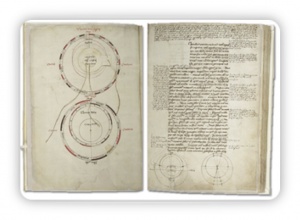
A recent acquisition by the University of Pennsylvania in April of 2018, known by its shelfmark “Oversize Ms. Codex 1881,” is a surviving example of how volvelles were utilized for practical purposes. As noted by archivist Nicholas Herman, the codex is a transcription of two scientific manuscripts from the 12th and 13th centuries, one written by the transcriber Gerard of Cremona, and another written by astronomer John of Sacro Bosco. It contains six functioning volvelles, including an illustrious double volvelle predicting solar eclipses. The author is unknown, but due to some pages written in Hebrew, it has been traced back to a Jewish community in Germany and dated to 1481 [10]. Interestingly, the manuscript was made of paper despite the popular use of parchment during this period. “Codex 1881” reflects the trend of preserving historical information by combining manuscripts from the previous two centuries, and also shows the dissemination of information between different parts of the world. It is equally important because it encapsulates the advancements of science up to the time of the Copernican Revolution [10]. Overall, the addition of the volvelle within the codex reflects the desire in the medieval era to update, synthesize, and create practical uses for older information. The volvelles in “Codex 1881” are very intricate and intended for a learned audience of scholars, reflecting its presumed sophistication. Its careful transcription and preservation show the devotion towards

documenting scientific discoveries in this era.
Volvelles, such as those contained in “Codex 1881” were a unique tool that expressed the functional breadth of the book, adding an interactive feature that allows the reader/user to prove the significance of the text and how it should be necessarily understood by future generations. “Codex 1881” is a compacted version of two manuscripts through the addition of the volvelles. Therefore, it can be considered an updated miniaturization of the past. This concept of “miniaturization” as devised by the philosopher/architect Paolo Soleri refers to the tendency of condensing the past achievements of human evolution into conceptual and/or physical structures [11]. The volvelle uses the book as its background and necessitative container, and the creators utilize the flexibility and piercability of the page to insert turnable circles with axles or thread. The technology of paper is elevated into a new miniaturized form of ideas, a feat of engineering, harnessing both the strength and weakness of paper. Used mostly an astronomical tool at during this time, it condensed and transfigured the knowledge of orbitals and star identification into a portable practical tool. As a feature of the book, it transformed and “miniaturized” information into an interactive design for the purpose of determining the future, advising where to look or what is to be seen. It was a direct aid to the future of human evolution, which echoes the entire purpose of “miniaturization,” as a form of preservation and interpretation through constant recontextualization in history.

Apian Wheels
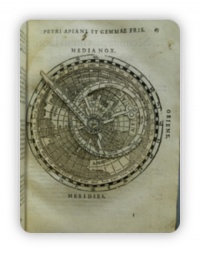
One of the most widely disseminated manuscripts that included the printing and assembly of multiple volvelles was Cosmographicus Liber by the German mathematician and printer Peter Apian. Originally produced in 1524, it was subsequently reprinted over 30 times in 16 different languages by several different printers [8]. Known as “Apian Wheels,” the intricate instruments contained in Cosmographicus Liber are the first known instances of mass production of volvelles through a printing shop. According to Anthony Drennan, this required careful instructions to the binder as to their location, collation, and assembly in later editions by other printers. Most notably, the six volvelles containing 15 cut

pieces included standardized notations or pictorial depictions of how to use them, demonstrating a more universal understanding of this technology among its users [8]. As Cristiano Guarnini has noted, this increasing popularity came from the specialized application of these volvelles, “ranging from land and building surveying, map projections, and instrument making to varied but related disciplines such as astronomy, geography, cartography, and navigation.” As with “Codex 1881,” Cosmographicus Liber demonstrates an attempt to record and miniaturize information. However in this instance, it is the inclusion of standardized notation or pictorial demonstration with the instrument that indicates that it began to work more independently of the accompanying text by providing instructions directly with the chart, thus simplifying their use.
Modern Volvelles
These instruments/book technologies deriving from the medieval Ages have persisted through the centuries, but in entirely different forms and for different purposes. They began as the precursor to the calculator, the only form of its kind at that time that could create calculations based on moving variables placed in desired positions. Yet, the volvelle’s unique adaptable design has allowed it to persevere, gradually disconnecting itself from the book. The modern day version of this instrument cannot be considered a volvelle in the strictest sense since the medieval volvelle relied on the accompanying text for its meaning. Instead, these instruments should be considered a form of self-contained ephemera. As Jessica Hefland has noted, the proliferation and mass production of wheel charts in the 1950s were afforded by invention of the die-cut printing process, which allowed for widespread dissemination within popular culture [12]. These instruments provided information, ranging from the radiation dosage calculators used during the cold war, to diet and nutrition wheels guide that provided advice on meals. These charts continue to be used in education and as an aid for visual learners of all ages, and its continued popularity could be attributed to its physical nature, its ability to be manipulated by the user, and a nostalgia for manual control. Therefore, the wheel chart as a descendant of the volvelle is still attractive in the same way that the printed book remains attractive in the era of ePublications.
-

The Radiation Dosage Calculator from 1950 was used for the Connecticut State Office of Civil Defense during the cold war. It allows one to calculate the exposure rate within a certain time and distance from the source of a nuclear explosion. -

This is a diet and nutrition guide that allowed doctors to provide a handy way to provide advice on meals and nutrition by moving the dials on particular foods, which would then indicated the type of vitamins and minerals contains in each type of food. -
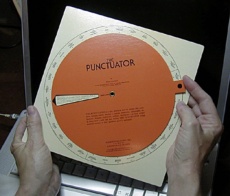
This is is a double-sided Punctuator from 1961 and a user would point the wheel on a grammatical element and the revealed text within the pointer provided the conventional punctuation. It was used from teachers and students to secretaries and authors. -
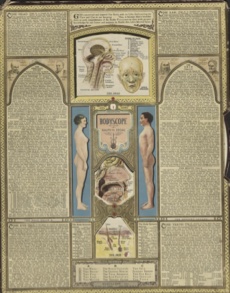
The Bodyscope is a color-lithographed, anatomical chart designed for educational use from 1948. The chart displays a male and female figure. Each figure includes a volvelle that, when rotated by the hand, provides a different display of the muscles, skeleton and internal organs.
Conclusion
The use of the volvelle, whether it was during the medieval era or as a wheel chart in mid-20th century, shares a common core principle in its ability to actively construct rather than passively instruct certain kinds of information for the reader/user. The origins and intention of this instrument began as a means to prove the infallibility of Christian thought against the spread of Islam, but its structure proved to be adaptable to other uses within astronomy that had practical applications. As a movable part of a manuscript, it proved to be a vital resource for predicting solar and lunar events as well as the movement of the planets for the purposes of travel, medical applications, and agricultural uses, among many other everyday activities. As a means for calculating and rearranging information, its decline in use only resulted from the flawed theories of the geocentric understanding of the universe on which it was based. However, it is the desire to miniaturize or re-contextualize information into a usable and adaptable format that allowed the concept of the volvelle to reemerge in the 20th century. As a visual form of learning, the modern wheel chart has evolved into an independent form of ephemera separate from the book, but its origins in medieval thought reflect the innate human impulse to constantly reevaluate information in a purposeful way that has always had the ability to bring relevance to everyday life.
Notes
- ↑ 1.0 1.1 Hern, Alex. “World’s Most Delayed Software Released After 54 Years of Development.” The Guardian, 6 June 2014. https://www.theguardian.com/technology/2014/jun/06/vapourware-software-54-years-xanadu-ted-nelson-chapman Accessed 1 Oct. 2018
- ↑ 2.0 2.1 Drennan, Anthony S. “The Bibliographical Description of Astronomical Volvelles and Other Moveable Diagrams.” The Library, Volume 13, Issue 3, 1 Sept. 2012, Pages 316–339. Oxford University Press: University of Oxford https://doi.org/10.1093/library/13.3.316 Accessed 1 Oct. 2018.
- ↑ 3.0 3.1 Werner, Sarah. “Volvelles.” Folger Shakespeare Library. 11 December 2012. https://collation.folger.edu/2012/12/volvelles/ Accessed 1 Oct. 2018.
- ↑ 4.0 4.1 Karr, Suzanne. “Constructions Both Sacred And Profane: Serpents, Angels, And Pointing Fingers In Renaissance Books With Moving Parts.” The Yale University Library Gazette, Vol. 78, No. 3/4 (April 2004), Pages 101-127. https://www.jstor.org/stable/40859568 Accessed 1 Oct. 2018.
- ↑ Martin, Rheagan. “Decoding the medieval Volvelle: Made from circles of paper or parchment, the volvelle was part timepiece, part floppy disk, and part crystal ball.” The Iris: Behind the Scenes at the Getty, J. Paul Getty Trust, 23 July 2015 http://blogs.getty.edu/iris/decoding-the-medieval-volvelle/ Accessed 1 Oct. 2018.
- ↑ 6.0 6.1 6.2 Priani, Ernesto. "Ramon Llull", The Stanford Encyclopedia of Philosophy (Spring 2017 Edition), Edward N. Zalta (ed.), https://plato.stanford.edu/archives/spr2017/entries/llull/ Accessed 30 Sept. 2018.
- ↑ 7.0 7.1 Jones, Alexander Raymond. “Ptolemaic System.” Encyclopedia Britannica. 16 June 2008. https://www.britannica.com/science/Ptolemaic-system Accessed 30 Sept. 2018.
- ↑ 8.0 8.1 8.2 Guarnini, Cristiano. “Peter Apian's Cosmographicus Liber.” Thinking 3D: University of St. Andrews. 4 Dec. 2017. https://www.thinking3d.ac.uk/Apian1524/ Accessed 30 Sept. 2018.
- ↑ Miranker, Emily. “The Original ‘App’: Paper Volvelles.” Books, Health, and Medicine: The New York Academy of Medicine. 12 June 2017. https://nyamcenterforhistory.org/2017/06/12/the-original-app-paper-volvelles/ Accessed 30 September 2018.
- ↑ 10.0 10.1 Herman, Nicholas. “medieval and early modern manuscript acquisitions: A bumper crop for 2017.” Schoenberg Institute of Manuscripts: University of Pennsylvania. 18 Feb. 2018 https://schoenberginstitute.org/2018/02/18/manuscript-monday-ms-codex-1881-astronomical-treatises-and-tables/ Accessed 30 Sept. 2018.
- ↑ Soleri, Paolo. Arcology, The City in the Image of Man. Cambridge, MA: MIT Press, 1969.
- ↑ Hefland, Jessica. Reinventing the wheel: Volvelles, equatoria, planispheres, fact-finders, gestational charts. New York: Princeton Architectural Press, 2002.